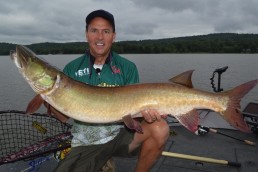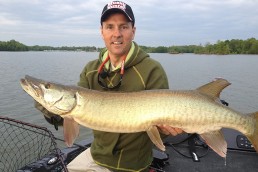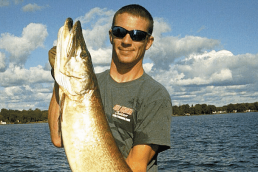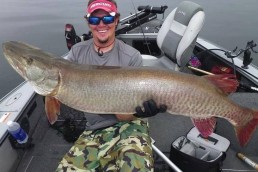Social-network Muskies
SHARE THIS POST
We are certainly living in the Information Age. It’s amazing how many different ways you can obtain muskie-fishing information or interact with anglers. You can now quickly shorten your learning curve and find out about any water, resort or lure. And there seems to be no shortage of individuals willing to comment on any muskie topic either, whether you’re visiting an internet forum or going on Facebook, Instagram, Twitter, etc. In addition, with point-of-view cameras there is a slough of videos posted almost daily.
The bottom line is if you’re looking for some information about a particular muskie lake, lure, technique or just want to be entertained, social media offers a plethora of opportunities.
It’s interesting how the exchange of information continues to evolve. There used to be a flood of information regarding “hot” bites that was first present on website forums. This made it easier to figure out where the bite was on. Lots of anglers used these to plan their weekend muskie trips, as they could and still can discuss a variety of muskie topics.
Over time, some of the various guides who initially relied on these forums to help build their business also realized the impact a few photos and fishing reports can have on a lake, in regard to their business. It helped them book guide dates, but it also resulted in increased weekend fishing pressure. Eventually, fewer of these photos were posted on their personal and business sites, and disappeared. As Facebook, Twitter and YouTube came more onto the scene, more muskie photos migrated to these. Today, you can view a multitude of social media channels and see all kinds of photos, videos and have access to information on the local bite. In some instances you can even determine the hot lures and the pinpointed, actual locations. Ultimately, I’m sure it’s just a matter of time until these photos and videos disappear from some of these sources as well. Until then, I’ll give you some ideas on how to research your chosen water during the winter and for the midseason.
It’s important to realize that following online for hot muskie bites usually results in you showing up too late. Nevertheless, it makes sense to use social media to obtain information on the local conditions and as well as any tidbits to help you the following season. Why not use all and any tools that are available?
One of the first approaches is to simply search “Muskie fishing on Lake X” and “Muskie guides on Lake X” or “Resorts on Lake X” to help find multiple resorts. These should also have any muskie pictures. These pictures can provide information on the size of these fish that are available as well as the timing to when these fish were actually caught. Many resorts may have guides too, so write them down now. The guide search will produce the names of these guides on that lake and they can more than likely provide information about the water and their muskie catches. The general search regarding “Muskie fishing on Lake X” more than likely will highlight several YouTube videos. It’s important to watch every video so you can relate to that particular lake better. You’ll note lures, possibly a recurring background, most productive weather conditions, dates of the videos, to discern the most productive times of year, etc.
Are you enjoying this post?
You can be among the first to get the latest info on where to go, what to use and how to use it!
Once you have completed the search and researched turn to Facebook and check out pages from the resorts and guides. Here you will find even more photos with key information, such as lures, that may be lying in the background. The skies you see on the posts on a site are also clues to productive weather conditions, the dates and sometimes even the times of the catches. If the guide or angler doesn’t turn off the location feature on their smartphone or device, you can actually see the closest town or nearby boat ramp to use, which is extremely helpful on larger waters. While on the guide’s page, take note of the various friends and others, both posting and commenting. Most likely those are anglers who also frequent “Lake X.” Visit their Facebook page too and go through the same muskie-exploring exercise. You can even take it a few steps further by looking into their friends as well. It really doesn’t take long to gain a handful of names of guides and other individuals who regularly fish a lake. You need to invest in a lot of time, but you’ll be amazed how much you can learn.
You can scroll through individual’s pages and see their photos that clearly illustrate the most productive weeks of the season, watch lots of videos revealing conditions, lures used and noticeable background features you need to watch for while later on the water there. During the season you can quickly get an idea if the muskies are biting or not by observing the posting habits of guides or individuals who fish “Lake X” often. There are individuals who only post when the fish are biting, and others who post throughout the season, regardless of the conditions. So during the season, if the individuals who only post when the muskies are biting, you can bet the bite is on at that time.
Some of this information is old news to some, new to others and plain frightening to others. Not all fishermen may realize that any photo, video or comment they post on a social media channel may be used for someone else’s gain. It may seem like fishing espionage, or cheating or stalking, but it happens every day, every season, even now in February when many are planning trips. So, you might want to consider not only what you want to post, but also whom you allow into your Facebook friend group. Online resources are tremendous for muskie waters and understanding the peak times and lures for that water. If guides and weekend warriors want to post photos, videos and reports on their catches, that’s awesome. But just realize that before you post anything to think twice about what that photo might reveal and the ramifications.
In the end, when you get to the lake you still have to apply your skills to catch the muskies and realize a computer is not going to catch them for you. If you really want to be successful, you need to develop a network of friends or contacts that can give you the straight scoop on what is happening. In addition, you need to spend time on the water to hone your skills and learn how to adapt to the changing conditions and how to work multiple lures. Having a network of close friends sharing information can pay off, but sometimes we will all still stumble into an oddball pattern. Remember, no matter how much technical knowledge and skill you possess, a little inside information can go a long way through a network of fishing friends.
As we enter into a new muskie era, almost everyone and everything happening is public information, and fewer secrets exist. It’s time to work on refining your skills, utilize all of the tools in your tackle box, maximize the effectiveness of your equipment and develop that network of muskie friends. Utilizing your social media sources is something that just can’t be ignored.
MWO
SHARE THIS POST
Did you enjoy this post?
You can be among the first to get the latest info on where to go, what to use and how to use it!
Jim Saric
Jim Saric is a Legendary Angler in the Freshwater Fishing Hall of Fame, the host and executive producer of The Musky Hunter television series, editor at large of Musky Hunter magazine, a seven-time muskie tournament winner, and a contributing writer for numerous other publications.



